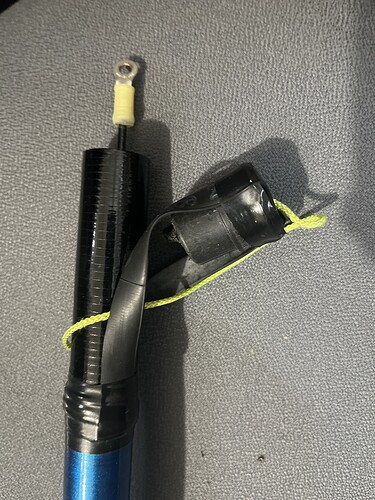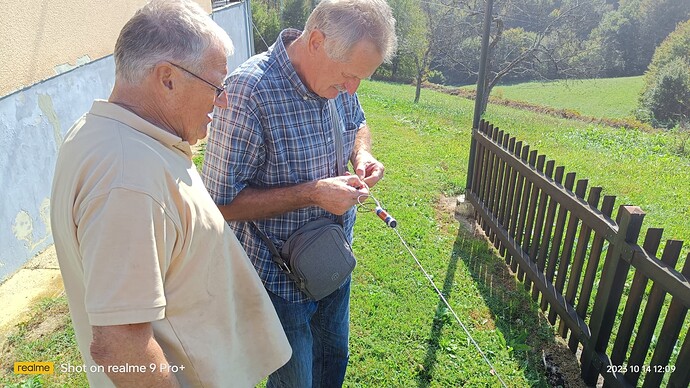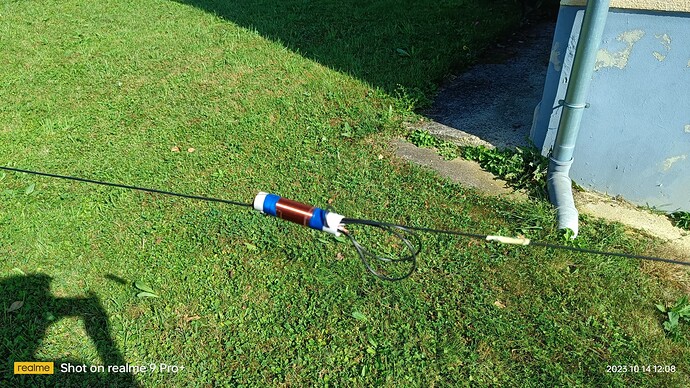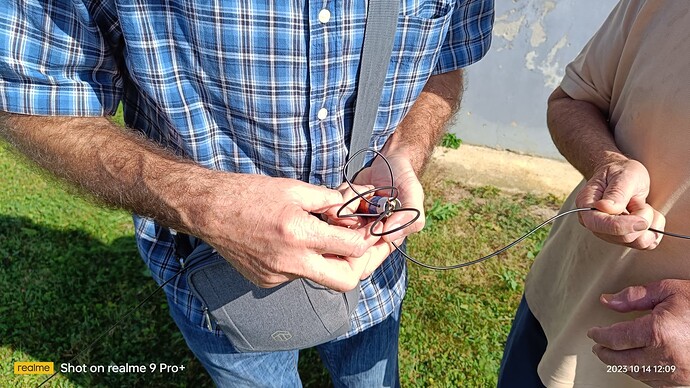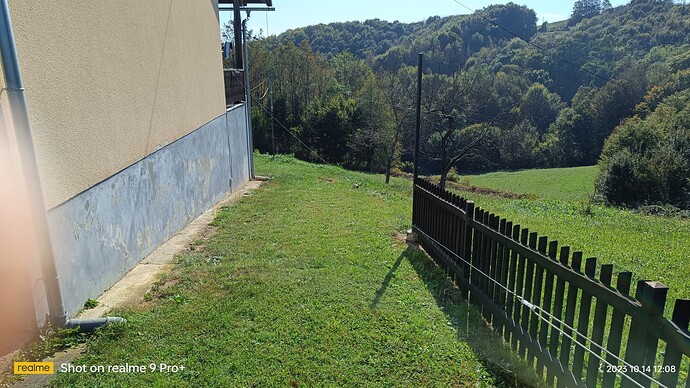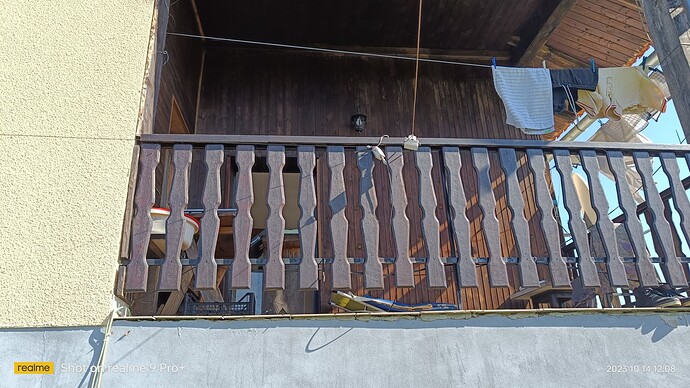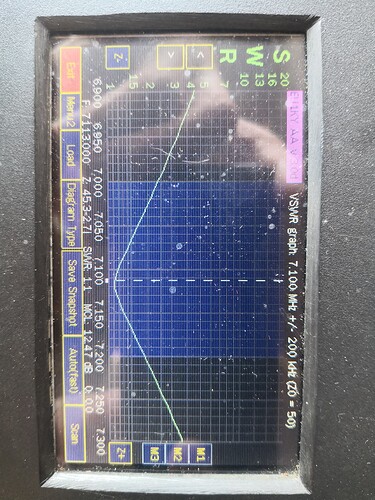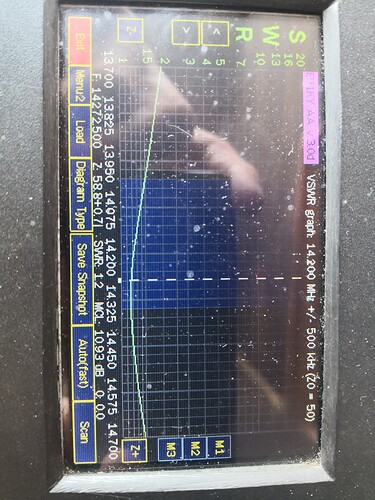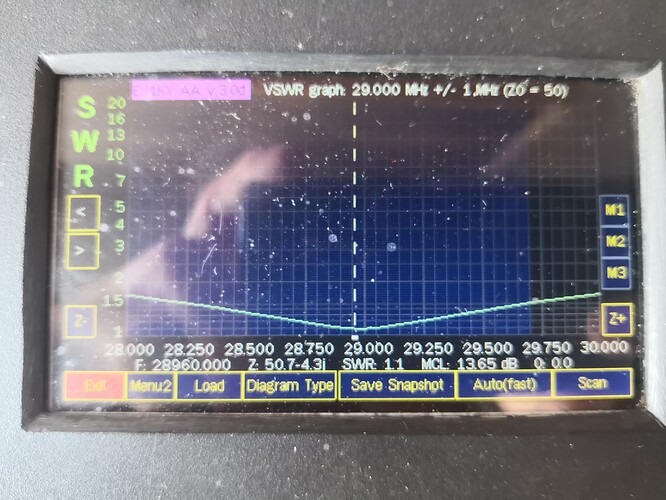Karlo, if the wire is distributed in an inverted-L, with one length coming down the pole (not around it but from the tip to a point near the bottom, then the rest of the wire going out from the pole in one direction, pole requires no guying of any kind. Most simply, hang the wire over a tree branch using the pole as a tool… or lean the top of the pole in the branches of a tree… or, stick the base of the pole in a bush… or brace the pole between some rocks… or put a spike in the ground and the base of the pole over it… or bungie cord the base of the pole to a stump. Note that I use #26 gauge teflon coated wire, no end insulator, and support it with forty pound test fishing braid, which does not stretch, feather light, and essentially no wind resistance… be creative! Have fun! … fred KT5X (WS-zero-TA)
There are distinct disadvantages to a sloper EFHW fed at the low end compared to an inverted-L fed at the bottom of the L.
The highest part of the sloping wire, that attached to the top of the pole, does not radiate. It has no current on it. With the inverted-L, the highest part of the wire at the top of the pole also has the most radiation.
The full length of the wire, potentially 67 feet for a 40M EFHW, is supported, drooped, by the pole. This may force the use of a heavy pole. With an inverted-L, the first fifteen feet of the wire is vertical up the pole, shortening the supported length considerably.
In the inverted-L the bottom of the vertical has no current on it (EFHW), and the wire itself may be used as the feedline, eliminating any coax.
73 fred kt5x
Interesting how different experience leads to different solutions.
+1 for the inverted V. I find slopers take much longer for me to set up, especially in windy conditions or uneven ground. If you go for a sloper, then @G8CPZ 's advice makes sense (i.e. might try it myself) of using 4 guys. I’ve always had to attach a long bit of cord to the end of the antenna to peg down from the mast to the ground on the far side to get the sloper configuration stable in windy conditions.
For an inverted V I use a single guy rope pegged down at both ends (so effectively 2 guy points). I run out and peg down the antenna wire first, leaving sufficient slack for the pole (back-off about 1m from taut for a EF 40m HW)
90% of the time I can erect the pole simply by pulling it up to full height with centre of antenna attached to top, tying the centre of the guy rope to the 4-5 section pole junction, leaning mast over a bit (in the downwind direction if windy) and then walking out the upwind end of the guy rope and pegging / tying it off to ground / tussock/ branch. Then repeat for the other end of the guy rope before the wind direction shifts. The inverted V (with correct tension) holds the mast sufficiently whilst I do this.
10% of the time it all goes wrong, the pole self-collapses, the antenna tangles itself round every bit of rock, scrub, landscape available and I curse myself for still being useless at this after 250+ SOTA summits.
That’s true even if fed from the top end. At resonance the current in an EFHW is a maximum and the voltage a minimum mid way along the wire, i.e. we have a node at each end and an anti-node in the middle. Therefore, it shouldn’t matter to a sloper which end it is fed from (top or bottom) as the V/I distribution is symmetrical.
For years I had the Z-box at the top of the mast (fed by a 10m coax) and only more recently changed to feeding the EFHW at the low end (via a 2m coax). I haven’t done A vs B comparisons but I can’t say my reports (received or sent) have changed.
One could argue it would be better to use an inverted V as the mid point is higher than the mid point of a sloper. I’ve tried that. But, as I argued earlier unwinding (from a single winder) and erecting a sloper is quicker than an inverted V. If I’m going to use an inverted V configuration I might as well take my [centre-fed] linked dipoles.
What you haven’t mentioned is, to what is the far end of the inverted L attached? Is that section horizontal?
Agreed. I carry guying kit but rarely need it here in W7W. I can almost always find a tree, bush, or rock to keep the pole upright. That was not the case in Iceland, where I had to use my guying kit quite a lot. On one summit my wife held the pole upright for a ‘hurry up’ activation on a windswept summit that was devoid of vegetation. I could have guyed, but it would have taken a lot more time (and it was windy, wet, and freezing).
So far in 475 activations I have always found a way to get the antenna up and get enough QSOs to qualify the summit!
My EFHW is deployed Inverted V style.
Feed point end is tied to my walking pole if nothing else near by that end and 3m of rg174 feedline drops into KX3 or FT817. I use a SOTA Beams tactical mini pole and 3 pieces of plastic covered wire to tie the pole to what ever is on the summit be it a fence post, bush , fallen tree branches are good. I had never guyed my pole in 450 activations the ground would be too hard to get pegs in the ground. On the far end of the antenna is 4 metres of cord which puts the end of the antenna about 1.5 m off the ground making a nice 65 degree inverted V shape on a 6m support. Where the antenna is tied to the pole my string has a floating insulator which can slide along the antenna wire making set up easier as you can not always achieve the exact same config or inverted V shape due to the lie of the land on some summits.
Regards
Ian vk5cz …
I know that many summits in the US are covered in trees, hence the experts we read about who throw weighed guy cords up around branches. But here in the UK especially in the north, most of the summits are rocky or grassy moorland and usually treeless.
So, unless you know the summit or can study it via photographs, one has to assume [here in the UK at least] that there will be nothing natural (like convenient tree branches) to aid in a solution. The telescoping mast and guying ropes is a universal solution provided there’s room for a wire antenna at the summit.
And sometimes there isn’t, and I’m glad then if I took a vertical with its smaller footprint (notwithstanding the counterpoise wires).
Looking forward to finding out! I’m headed to Scotland next summer to visit some friends and have a nice holiday. I plan to get on as many summits as my wife will allow. I will be prepared to deploy the guying kit!
Yes! An inverted vee fed at either end, puts the maximum radiation portion of the wire up higher. The reason for an inverted-L instead of an inverted vee, is that the inverted vee pulls equally in both directions making the top of the (assumed flimsy for light weight) pole flop around especially in the wind. An inverted-L has the wire pulling to one side, so the pole is fairly steady and the pole can be “braced” instead of guyed. - fred
I use an 5-6m pole, very lightweight, collapses down to about 45cm. Never use any guys. Often times have no trees, in which case, I pile some rocks around the base of the pole, find a hole in the rocks, etc. I’ve even put the pole in my backpack and held the backpack between my knees.
For wire config, I’ve used inv-L, inv-V, sloper. No coax, direct to a 49:1 plugged into the rig. Despite the minimalist approach I’ve never failed to make 4 qso’s. Could I have made more contacts with a better configuration? Yes, but I’ve found the above to be good enough for my needs.
KT5X Fred has it right! I also use the inverted-L, usually 20M of wire, about 65 feet, #24 teflon stranded silver-plated, just right, even in pretty strong wind. #26 is too light for Colorado summits.
Usually I use whatever is available to support the pole. On high, bare summits, I usually have two small dacron cords attached to the pole about 5 feet above the ground. These cords need to be 15-20 feet long, and about 2mm diameter. The bottom of the pole must be constrained by rocks, or a hole, so it won’t move. All you need to attach small cords is a thick rubber band wrapped a few turns around your pole. Tie the cords above the rubber band. These cords go to rocks. They must be adjusted - too tight, and the pole may collapse - too loose,and the pole moves around. The antenna itself is the third guy, but in high winds, I use a third cord also. Erecting the pole is easier, and stability is better, if the antenna is lined up with the wind, or into the wind. Erecting a pole and wire takes practice, but you learn tricks as you go.
Using rocks piled around the base of the pole works only if:
- There is little wind
- The pole can bear the severe stress from the leverage
- Or you use a protective cylinder of thick PVC - or whatever - around the base of your pole
If you pile rocks around a lightweight pole to support it, you will ruin it, as soon as a big gust of wind hits it.
The far end of the wire is tied with another dacron cord to whatever is available. If there are trees, sometimes I use a rock and cord to get the far end up over a branch. This is an art. On bare summits, the end of the wire is sometimes near ground, but there is little difference in performance. You can pile up a few rocks to raise it, if you have time. It’s OK to run parts of the wire over rocks - or trees - in order to get it higher.
I use a 6M carbon-fiber pole that weighs about 7 ounces. The tension on the wire is enough to curve the upper part of the flexible pole. Most of wire hangs a few feet out from the pole. I sit near the bottom. I use about 0.8M - only about 2-1/2 feet of RG-303 teflon coax between the KX2 and the tuner. Both sit on the ground next to me. We are the counterpoise.
I use a homebrew tuner, several different kinds. Key points:
- True tuned matching circuits with several variable elements
- Almost perfect matches from 60M band through 10M band
- Radio sees 50 ohms
- Usually no counterpoise, but it’s OK to use one, especially for lower frequencies or non-resonant wires. Start with 4 or 5 meters. The counterpoise is part of the radiating antenna. Raise it if you can.
- Reactive antennas can be tuned easily with tuners designed for this
- No links or traps needed with wide-range tuners.
If you use any kind of coax, you will have significant loss on some bands:
- If the coax is more than 1 or 2 meters
- If the coax is not terminated in 50 ohms
- If the antenna is not resonant and not matched on some bands
Really, coax is not your friend in the mountains. It weighs a lot, it adds loss, and it restricts you to a low impedance with a limited frequency range.
Do not run coax up the pole. Use only a short piece to your tuner or matching circuit. Coax going up the pole works against everything you’re trying to accomplish.
Keep everything as simple and light as possible.
Make sure you can get the pole down fast if a storm rolls in. With the arrangement I described above, the entire antenna comes down if I lift and tilt the pole with one hand.
73
George/Carey
KX0R
Andy, 9A3BKF did not specifically ask about erecting a pole on a summit, he was asking about 3 points of anchorage. He is obviously new to portable operating with a mast and I thought a simple video showing the basics would assist him. I am fully aware of the factors involved in erecting a mast, especially on summits in GM land; as can be seen from my callsign I live there! I am unsure why you replied to me and not the originator of the question but thanks for the advice. 73 de 2M0NEG.
“It’s not the class of license the Amateur holds, but the class of the Amateur that holds the license”
I use a short length of plastic pipe, just a little wider than my pole. I’ve never had to use guys. This can be driven into soft ground or jammed into rocks etc. put into position before you put the mast into it.
See also Fraser’s post.
I have a short slot cut into the side to remove any soil stuck inside after use and I’ve cut one end as a sort of point too, which helps push it into the ground if it’s hard grass or soil.
Works every time for me and no tangled guy ropes to mess with in windy weather.
Hi Richard, that’s not how I interpreted his question. When he said “how do i set up the mast so it does not fall over?” I took that to mean during the erection process and after.
I wasn’t implying the SOTAbeams video wasn’t useful, rather that Karlo 9A3BKF to be aware of its limitations and why I included non-windy and very-windy methods of pole erection in my original post.
73, Andy
I meant the setting up in general,but yeah it is for summit activation since I’ve only used a vertical antenna on a tripod so far.
Today we configured the antenna now we just need to test setting it up on a pole ![]()
This doesn’t really address to question at hand but I want to share my solution to secure the top cap of the mast. The bright string in the photo is my old cap tether (no longer needed). The cap would often come off and the pole would start to extend if I had my pack tilted downwards for example. Very annoying. I used electrical tape to fasten a strip of rubber from an old bicycle inner tube over the cap. The strip has a hole in the center top with a screw and nut holding it to the cap. If you do this, leave enough length in the strip so you don’t stress it too much when you pull the cap off.
I take some 40-50cm twist-tie straps and lash the mast to a small tree or a post or just build a pile of rocks around it to hold it erect.
VA7SGY
Thanks everyone for the input,the antenna is done,now I just need to try setting it up with the mast!
Some photos from the SWR measuring and cutting it to the correct length.
Thanks to 9A1IB and 9A3ZH for the help.
40 meters isnt too great at the upper and lower end since I dont use a tuner,but we were close to a wall so out in the open it should(?) Be a bit better.
You seem to be less than 2:1 across the entire band on 40m. You could try elevating each end by 1m and see it that helps. It may vary by ground type and proximity to fence wires etc.
